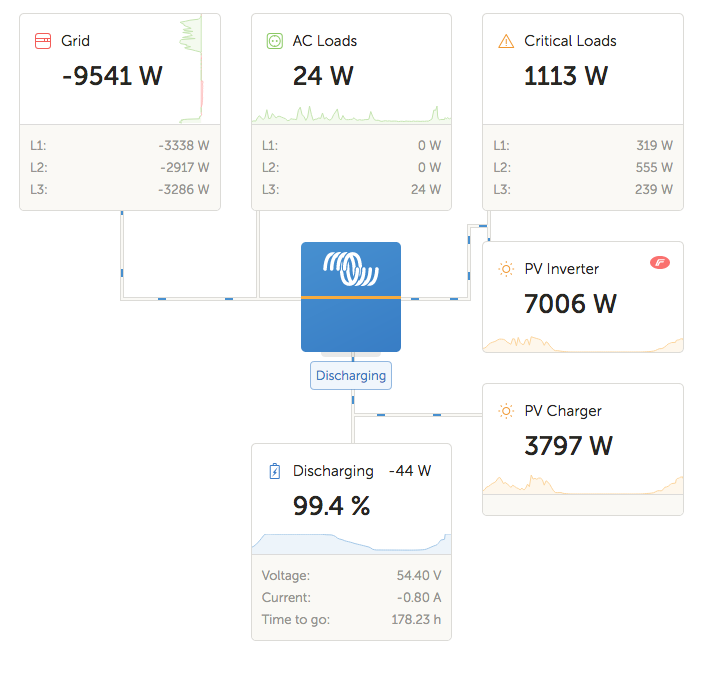Hello,
I would have a question about the configuration of a 3-phase system in a family house:
3x Multiplus II 48V / 5000VA / 70A-50A.
Battery storage 3x BYD LVS 4kWh - total 12kWh.
PV panel 12x Longi 445Wp (total 5340 Wp).
Cerbox GX with GX Touch 50
The system would be connected to the grid, including grid overflows, when the batteries are charged and the load is covered.
Unfortunately, in my country, the distributor uses electricity meters to measure each phase separately. So I need Multiplus to regulate each phase to zero at the meter measuring point in case of enough energy from the panels.
So my question is:
It is better to connect the panels as AC coupled via SolarEdge inverter with optimizers on each panel (for higher efficiency). Or use a DC coupled connection with MPPT 250/85 Tr VE.Can.
In the ESS manual, I read that with the Three-phase ESS with the Multiphase regulation setting - "Individual phase" there are large losses regarding the conversion of DC-AC (panel-inverter) and subsequently AC-DC from one phase via multiplus to DC- AC to another phase via multiplus.
btw if possible, then I want to use all the electricity produced in the house, only overflows in excess of my own consumption to send to the network as the selling price is 10% of the purchase price of electricity.
thanks for the anwers
Luke
- Home
- Anonymous
- Sign in
- Create
- Spaces
- Grafana
- Node-Red
- Unsupported topics
- Questions & Answers
- Modifications
- Communauté francophone
- Deutschsprachiger Bereich
- Preguntas en Español
- Explore
- Topics
- Questions
- Ideas
- Articles
- Badges
question
Multiplus II DC or AC Coupling with 3Ph ESS - individual phase compensation
Hi @Lukas L
I have similar system (a bit bigger) and I have AC coupled 10kWp and DC coupled 6kWp.
It is good to have DC coupled part in case there is no grid and batteries get discharged down to OFF level. In that situation MPs are off and, without DC coupled part, there is nothing to charge the batteries even with Sun at full blast, and your house is dark.
Also charging battery from DC is more efficient then from AC.
I do not understand your distributor situation.
Why you want to ZERO each phase separately if you can send electricity to the grid?
In my system, when battery is full and PV production is higher than house loads, I feed my excess PV energy to the grid.
I my country I can later (within a year) take 80% of my "feed" back for free.
If I understand you correctly you can sell it for 10% of the purchase price.
So, if you have more PV production than you consume at the moment, it is still worth to sell than to waste it by limiting production.

Hi Marekp
thank you for answer.
The problem is precisely the difference between the sale and purchase price of electricity.
My Electricity Distributor measures each phase separately and therefore when I take 2kW from phase 1 and I have 1kW overflow in phase 2 and 1kW overflow in phase 3, so I have to pay the full price for 2kW and they pay me only 10% of thay price for 2kW that i send back to the grid.
So I need an asymmetrical division into each phase to primarily use the energy from the PV panels exactly where it is needed (the battery is fully charged).
Let's say I don't want to keep each phase at 0W, but I need to avoid overflows on other phases into the grid when this energy could be used on the phase that draws energy from the grid.
And for this reason, I am currently deciding whether it is more efficient to use DC coupling or AC coupling. Since in pure AC coupling I assume that it will happen that the energy from eg phases 2 and 3 will be transferred to the DC part and then by the converter to be converted to phase 1 in order to balance the consumption from the network to phase 1.
So I don't know if it wouldn't be more efficient to use only DC coupling, where the whole PV array is connected to a DC part and then each inverter generates only the part of the consumption that the given phase takes + somehow divides the overflows to the grid.
Thank you
Ok I got it. :)
I do not think you will be able to prevent this from happening 100% of time.
To minimize it, I would balance loads on phases and make AC coupled PV only big enough to cover the average house load, but it would be difficult to find 3 phase PV inverter smaller than 3kW.
The rest of PV, I would connect as DC coupled.
Conversion efficiency of the AC inverter is around 97%.
Conversion efficiency of the MPPT is around 98% but DC-AC conversion efficiency of the MP-II is between 89 and 93%. Also battery has its own storage losses.
Best Regards,
Marek
I agree with Marek, some AC and DC is best.
I would use the 450/100 instead of the MPPT 250/85.
It has two trackers and you can go much higher voltages and reduce cables but if you install the 450/100 you might has well install all the PV on it unless you have some shading problems.
I am not normally concerned about DC-AC vs DC-DC-AC conversions on residential installs as half of your power produced is most likely going to charge the batteries anyways and DC-AC-AC-DC is less efficient than DC-DC.
question details
51 People are following this question.
